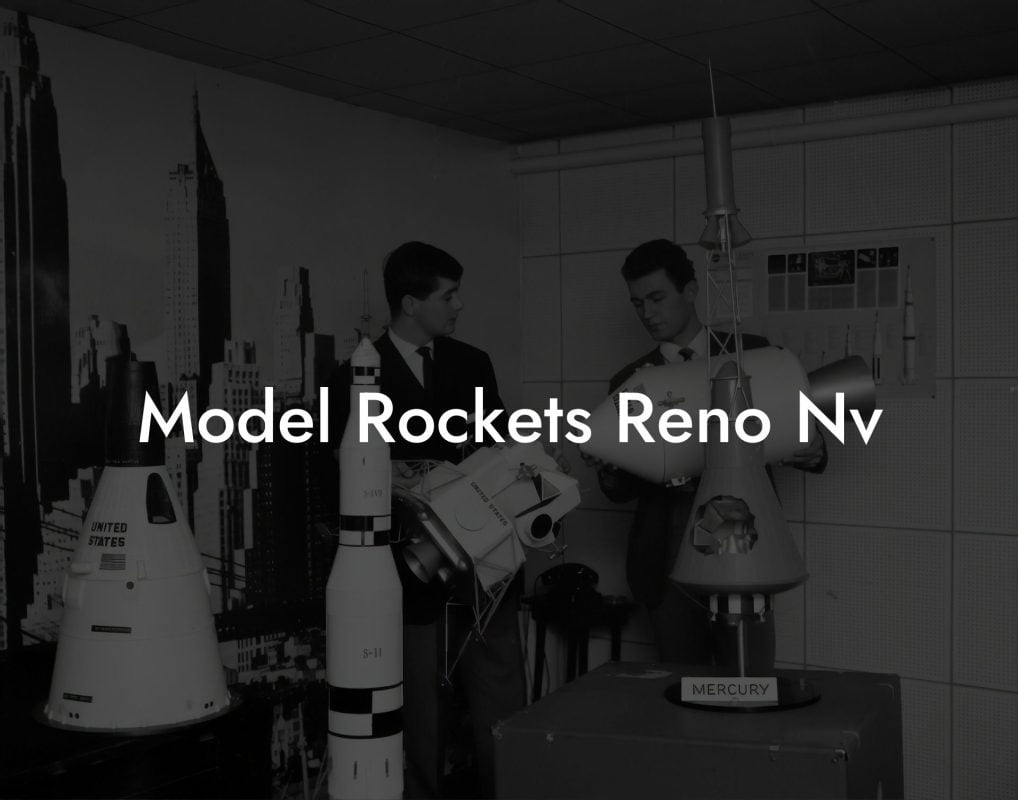Imagine soaring into the stratosphere, defying gravity, and exploring the unknown with your very own model rocket. Welcome to the world of model rocketry, where creativity meets innovation, and the thrill of adventure awaits. Whether you're a seasoned enthusiast or a curious newcomer, this comprehensive guide will propel you into the fascinating realm of model rockets.
Quick Links to Useful Sections
- What Are Model Rockets?
- The Benefits of Model Rocketry
- Getting Started with Model Rocketry
- Step 1: Choose Your model rocket Kit
- Step 2: Understand Safety Precautions
- Step 3: Assemble and Prepare Your model rocket
- Step 4: Launch and Recover Your Model Rocket
- Model Rocketry Communities and Resources
- Advanced Model Rocketry Techniques and Projects
- Altitude and Speed Records
- GPS and Telemetry Systems
- Custom Designs and Fabrication
- Frequently Asked Questions (FAQs)
- Resources and Community Support: Your Next Steps
What Are Model Rockets?
Model rockets are scaled-down versions of real rockets, designed to fly through the air, carrying payloads, and sometimes even returning to Earth. They're an exciting way to learn about aerodynamics, propulsion, and the science behind space exploration. From simple, DIY kits to complex, high-performance models, the world of model rocketry has something for everyone.
Model rockets can be powered by various propulsion systems, including solid-fuel motors, liquid-fuel engines, and even hybrid systems. They come in different shapes, sizes, and materials, catering to diverse skill levels and interests.
The Benefits of Model Rocketry
Engaging in model rocketry offers a wide range of benefits, from developing essential skills to fostering a sense of community and camaraderie.
- STEM Education: Model rocketry teaches valuable skills in science, technology, engineering, and mathematics (STEM), preparing you for careers in aerospace, engineering, and related fields.
- Critical Thinking and Problem-Solving: Designing, building, and launching model rockets encourages critical thinking, creativity, and problem-solving, essential skills for success in various aspects of life.
- Teamwork and Collaboration: Joining a model rocketry club or participating in competitions promotes teamwork, communication, and collaboration, helping you develop vital social skills.
- Fun and Adventure: Let's not forget the most important aspect – model rocketry is an exhilarating hobby that brings people together, creating lifelong memories and unforgettable experiences.
Getting Started with Model Rocketry
Embarking on your model rocketry journey is easier than you think. Here's a step-by-step guide to help you get started:
Looking For The Best Model Rocket Kits? You'll Love These:
Step 1: Choose Your model rocket Kit
Select a kit that suits your skill level, from beginner-friendly options to advanced, high-performance models. Consider factors like budget, complexity, and desired features.
Step 2: Understand Safety Precautions
Familiarize yourself with essential safety guidelines, including launch site selection, wind conditions, and proper handling of motors and propellants.
Step 3: Assemble and Prepare Your model rocket
Follow the kit's instructions to assemble your model rocket, ensuring all components are securely attached and properly aligned.
Step 4: Launch and Recover Your Model Rocket
Find a suitable launch site, conduct pre-flight checks, and launch your model rocket. After recovery, inspect your rocket for damage and make necessary repairs.
Model Rocketry Communities and Resources
Joining a model rocketry community or accessing valuable resources can enhance your experience, provide support, and help you stay updated on the latest trends and innovations.
- Local Model Rocketry Clubs: Search for clubs in your area, where you can meet fellow enthusiasts, participate in launches, and learn from experienced modelers.
- Online Forums and Communities: Engage with online forums, social media groups, and dedicated websites, such as the National Association of Rocketry (NAR) or the Tripoli Rocketry Association (TRA).
- Model Rocketry Magazines and Blogs: Stay informed about the latest news, trends, and product reviews through publications like Model Rocketry Magazine or online blogs like Rocketry Blog.
Advanced Model Rocketry Techniques and Projects
Once you've gained experience and confidence, you can explore advanced techniques and projects to take your model rocketry skills to the next level.
Altitude and Speed Records
Design and build high-performance model rockets to break altitude and speed records, pushing the limits of what's possible.
GPS and Telemetry Systems
Integrate GPS and telemetry systems into your model rockets to track their flight paths, altitudes, and velocities, gaining valuable insights into their performance.
Custom Designs and Fabrication
Develop your skills in design, fabrication, and machining to create unique, custom model rockets that showcase your creativity and expertise.
Frequently Asked Questions (FAQs)
Here are some frequently asked questions about model rocketry, answered to help you get started or overcome common challenges:
1. What is the best model rocket kit for beginners?
Look for kits with a low to moderate complexity level, such as the Estes Tandem-X or the Aerotech Initiator.
2. How do I ensure a safe launch?
Always follow safety guidelines, conduct pre-flight checks, and launch in an open area with minimal wind and obstacles.
3. What is the highest altitude reached by a model rocket?
The current Guinness World Record for the highest altitude reached by a model rocket is approximately 121,000 feet (36,880 meters).
Resources and Community Support: Your Next Steps
Continue your model rocketry journey with these valuable resources and community support systems:
- National Association of Rocketry (NAR): A leading organization for model rocketry enthusiasts, offering resources, competitions, and community support.
- Tripoli Rocketry Association (TRA): A non-profit organization dedicated to promoting high-power rocketry and providing resources for enthusiasts.
- Model Rocketry Forums and Communities: Engage with online forums, social media groups, and dedicated websites to connect with fellow enthusiasts, share knowledge, and learn from experts.
Embark on your model rocketry adventure today, and remember to always prioritize safety, innovation, and fun!
Looking For The Best Model Rocket Kits? You'll Love These:
Useful Interruption: Dive deeper into the world of Model Rockets with our most popular sections. If there is anything you think is missing or anything you would love for us to write about, just give us a shout.
- Getting Started & Basics With Model Rockets
- Model Rocket Design, Build & Customization
- Model Rocket Propulsion & Engine Technology
- Model Rocket Launch Techniques & Recovery
- Model Rocket Advanced Rocketry & Innovations
- Model Rocket DIY and Customization
- Model Rocket Equipment Reviews & Digital Tools
- Community, Competitions & Education
- Model Rocket Troubleshooting & FAQs
- Model Rocket Bonus/Seasonal & Niche Topics
A group of model rocket enthusiasts gathered at a field for their weekly launch event. Among them was Dave, a seasoned builder known for pushing the limits of hobby rocketry. This time, he had outdone himself.
“Ladies and gentlemen,” Dave announced, dramatically pulling a cloth off his latest creation, “I present to you: The Kraken!”
The crowd gasped. This wasn’t just a model rocket, it was a monster. The thing stood 8 feet tall, had six clustered engines, and was covered in enough duct tape to qualify as a classified aerospace project.
“Dave,” muttered Steve, the cautious safety officer, “Have you, uh… done the math on this?”
“Math?” Dave scoffed. “I built it in my garage at 3 a.m. with parts from eBay. This is an art piece, Steve.”
The countdown began.
5…
4…
3…
2…
1…
The engines ignited with a BOOM, and The Kraken shot up… kind of. It immediately did a violent barrel roll, narrowly missing the spectators before skyrocketing at an angle that could only be described as “legally questionable.”
The crowd collectively ducked as The Kraken flew straight over the adjacent cornfield, where Old Man Jenkins, the grumpiest farmer in town, was minding his business.
KABOOM!
The rocket disappeared behind the barn. A moment later, a flaming piece of Estes igniter wire landed at Steve’s feet. The silence was deafening.
And then, an unmistakable sound echoed across the field.
Jenkins’ shotgun being cocked.
“DAVE!!!” Steve shouted. “RUN.”
And that was the day Dave invented the first-ever biologically powered rocket booster: pure adrenaline.
To this day, nobody knows where The Kraken landed, but legend has it, it still haunts the skies, terrifying unsuspecting drones and low-flying birds.















